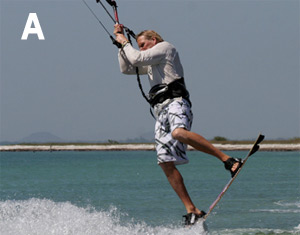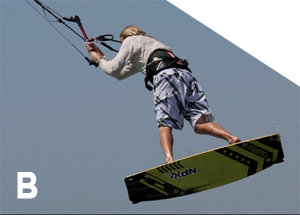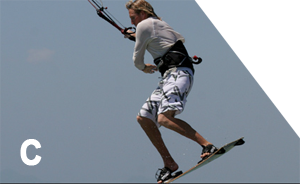Kite Loop to Wrapped
The Kite Loop to Wrapped is a desirable technique in its own right which demonstrates superior control and landing satisfaction. Though it is also a vital step to kite loop 3, surely, there are benefits in learning the wrapped version first.
Firstly, you have more time to focus on the kite loop as the timing for the spin is a last minute thing. Rather than looking forward for the moment to spin, better to wait for it. Secondly, you don’t need much height so you can get away with less power which makes a more pleasant learning experience. Thirdly, as an outcome of both of the above, to succeed is all about technique and has nothing to do with aggressive force. Once you’ve got it, you can move onto the full 3 version a whole lot easier.
If you are coming into this as a relatively new recruit to wrapped, it is recommended to practice on your shifty to wrapped first as this is the primary building block of a quick spin to wrapped.
HIGHLIGHTS OF THE TRICK
THE TAKE OFF
Whether you’ll be going for a kite loop with or without wrapped or a pass, what your kite does will affect your chances of success, and what your kite does is remarkably influenced by your approach and take off as you’ll be learning this technique with a fish pole grip, you have no way of controlling the speed at which your kite loops with your hands instead the rest of your body.
Chances are, when you first attempted an unhooked kite loop, you changed your hands and the kite looped before you had time to think, dragging you off downwind vigorously and most likely splash you into the water. The simple reason for this is that you need to pop to get off the water and let the kite do the rest when you’re up. If you just edge hard, you put more tension on the lines and the kite moves fast.
 In Pic A, the surfer basically just eased off downwind with the kite at 12:00, unhooked and reached under and back with front hand to grab the back of the bar and popped up off the back leg right away. You can see how the surfer’s whole body from feet to shoulders is aimed upwards and not back against the pull of the kite. Because the kite is not breaking the surfer up off the water, maintaining the arms bent is easy and therefore keep the bar close.
In Pic A, the surfer basically just eased off downwind with the kite at 12:00, unhooked and reached under and back with front hand to grab the back of the bar and popped up off the back leg right away. You can see how the surfer’s whole body from feet to shoulders is aimed upwards and not back against the pull of the kite. Because the kite is not breaking the surfer up off the water, maintaining the arms bent is easy and therefore keep the bar close.
Because the surfer is no longer resisting against the kite, it will turn slower. And because the surfer has popped up, the kite will hurl up providing more height effortlessly. The longer you carve on the water, the more vigorous the break from the kite, the further back the kite loop and the lower he resultant jump.
This will only be possible if you unhook with your front leg pushed out in front of you, your hips dropped right back over the rear foot and your shoulders back. From this state, you can swiftly carve and pop.
THE SHIFTY
We use the term shifty freely as we don’t want to get into any discussions about style. Let’s agree that in this case what we mean is the extension of the rear leg behind us. As with the shifty to wrapped by kicking your rear leg behind while in the air, you then can bring the knee up and through which will assist you to spin faster and further. For sure there are many surfers, who spin without extending their leg first, but we’re in the market of making this easier for all involved, and this absolutely helps.
The other benefit to this position is that it allows you to use the “flick” of the kite. This being the point at which the kite tries to knock you off balance, usually by swinging your legs forward as the kite turns back. With the back leg extended, you can then pull the knee up towards you to regain your stability and hyphen up your rotation speed.
 In Pic B, you can see that the surfer kicked his rear leg and foot up behind as the kite pulls. As with the shifty to wrapped, the surfer didn’t let those arms extend, instead keeps the bar close. Looking at the image, you can see that there is almost a straight line running from his hands through his back knee to his rear foot. If you were watching the kite, it would just be turning through the bottom of its arc and is beginning to rise.
In Pic B, you can see that the surfer kicked his rear leg and foot up behind as the kite pulls. As with the shifty to wrapped, the surfer didn’t let those arms extend, instead keeps the bar close. Looking at the image, you can see that there is almost a straight line running from his hands through his back knee to his rear foot. If you were watching the kite, it would just be turning through the bottom of its arc and is beginning to rise.
THE ROTATION
More lower body work out here. It is all about getting your hips, legs and board to turn. Your upper body will follow your head but if you don’t get the lower half moving, it’s good as nothing.
 In Pic C, the surfer is dropping and feels that there is much less pull in the bar. This is the signal to start spinning and this is the advantage of learning to wrapped. In this image, there are two important things.
In Pic C, the surfer is dropping and feels that there is much less pull in the bar. This is the signal to start spinning and this is the advantage of learning to wrapped. In this image, there are two important things.
Firstly, if you look at the surfer’s right foot, you can see how it is lifted off the footpad. This indicates just how vigorously the surfer has pulled his knee, foot and the rear of the board forward towards his hands. Because of the shifty, the surfer was able to do this.
Secondly, look at the position of the left hand. It is almost wrapped around. This is because the surfer has not pulled the bar into his back hip, but rather has pulled the bar past the hip and down as if pulling a paddle along the side of the raft. So the hands have been drawn down towards where the rear foot was and the knee had been brought forward to get the board under the bar and the bar under the shoulders.
Once you get the board under, you can then rotate with your head to get your upper body around on a vertical axis. If you rotated before the knee came through, the board would be left behind, and you would rotate off axis and be dragged off balance.
FINAL STEPS TO REMEMBER
Before you go for any wrapped landings, give yourself more allowance by knocking out a handful of unhooked kite loops first. Aim about taking off early, extending the rear leg and feeling the tension disappears as you drop. This way, you’ll get a sense for when you need to spin and also provides you the right amount of power and height. If you feel like you are overdoing it, it may not be the right day to try.
Consider trimming your kite too. You want your kite to be looping circular, not to be turning around its wing tips. On the majority of kites, if you don’t trim them down enough to unhook, they will flare/reverse/halt. This will result in a tight wing tip axis and won’t give you the feeling that you need or much of a chance of succeeding. Defined and controlled is better than wild and unpredictable as you can build on it.
SEQUENCE SUMMARY
1. Have a good look around to make sure you have enough space. The surfer moves his kite up to 12 o’clock, pushing the board off the wind with a straight front leg unhooks with his shoulders still back.
2 & 3. After unhooking, you need to reach under and back with front hand to fish pole the bar, drops weight back and upwind.
4. Hard carve upwind and ready to pop…
5. ..and explodes up off the rear leg before the kite starts to pull. When you pop, you need to keep your arms bent and the bar in close.
6. As the kite loops back and down, it’ll pull you towards it. Kick the rear leg out behind and hold on tight. To help with balance, you can look over the bar towards the kite.
7. As the kite starts to rise, it stops pulling and you’ll start to drop as well. This is the perfect time to spin just as you feel the power. Pull arms in and down past the back hips hard and pull the rear leg in even harder.
8. Keep pulling on the bar, try to pull it past the hip and release only the front hand as your lower body and knee will come through.
9. With the lower body turning, start to turn your head and shoulders so that you can continue to spin far enough to land with the board pointing downwind.
USUAL PROBLEMS
- If you find that the kite drags you hard downwind and not skyward. For sure you are edging too long before popping up. Don’t wait for the kite to pull, just change your hands and pop.
- If you still couldn’t get enough height. Make sure that you start with the kite positioned as near to 12 o’clock as you could. You should hurl the kite up before you unhook.
- If you bounce off the back of the board when you land. You are not getting your feet forward enough as you rotate. Always bring your knees all the way through and up.
- If you can’t reach for the bar. Make sure you pull the bar down towards you and keep your arms bent all through the loop. Finally, you’ll need to pass out the wrapped nice and quick; otherwise the kite will just continue to loop around.
KEY MARKS
- Kite at 12 0’ clock
- Pop up early
- Keep arms bent
- Kick rear leg back
- Bring hands and back knee together when you feel the power coming.
You should do like this:

Leave a Reply